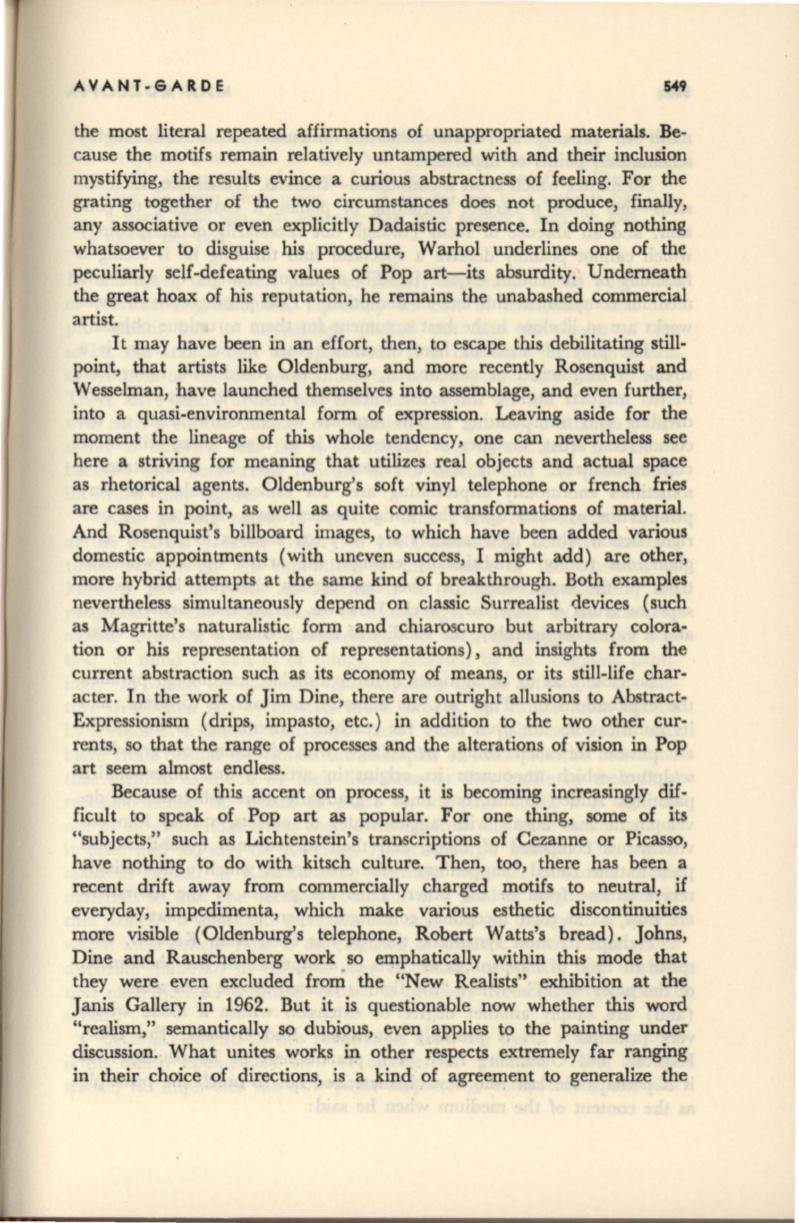

AVANT-GARDE
549
the most literal repeated affirmations of unappropriated materials. Be–
cause the motifs remain relatively untampered with and their inclusion
mystifying, the results evince a curious abstractness of feeling. For the
grating together of the two circumstances does not produce, finally,
any associative or even explicitly Dadaistic presence. In doing nothing
whatsoever to disguise his procedure, Warhol underlines one of the
peculiarly self-defeating values of Pop art- its absurdity. Underneath
the great hoax of his reputation, he remains the unabashed commercial
artist.
It may have been in an effort, then, to escape this debilitating still–
point, that artists like Oldenburg, and more recently Rosenquist and
Wesselman, have launched themselves into assemblage, and even further,
into a quasi-environmental form of expression. Leaving aside for the
moment the lineage of this whole tendency, one can nevertheless see
here a striving for meaning that utilizes real objects and actual space
as rhetorical agents. Oldenburg's soft vinyl telephone or french fries
are cases in point, as well as quite comic transformations of material.
And Rosenquist's billboard images, to which have been added various
domestic appointments (with uneven success, I might add) are other,
more hybrid attempts at the same kind of breakthrough. Both examples
nevertheless simultaneously depend on classic Surrealist devices (such
as Magritte's naturalistic form and chiaroscuro but arbitrary colora–
tion or his representation of representations), and insights from the
current abstraction such as its economy of means, or its still-life char–
acter. In the work of Jim Dine, there are outright allusions to Abstract–
Expressionism (drips, impasto, etc.) in addition to the two other cur–
rents, so that the range of processes and the alterations of vision in Pop
art seem almost endless.
Because of this accent on process, it is becoming increasingly dif–
ficult to speak of Pop art as popular. For one thing, some of its
"subjects," such as Lichtenstein's transcriptions of Cezanne or Picasso,
have nothing to do with kitsch culture. Then, too, there has been a
recent drift away from commercially charged motifs to neutral, if
everyday, impedimenta, which make various esthetic discontinuities
more visible (Oldenburg's telephone, Robert Watts's bread). Johns,
Dine and Rauschenberg work so emphatically within this mode that
they were even excluded from the "New Realists" exhibition at the
Janis Gallery in 1962. But it is questionable now whether this word
"realism," semantically so dubious, even applies to the painting under
discussion. What unites works in other respects extremely far ranging
in their choice of directions, is a kind of agreement to generalize the









